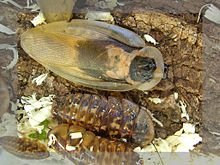Exopterygota
| Exopterygota Temporal range:Carboniferous–Recent
| |
|---|---|

| |
| Death's head cockroachor brown-wingedBlaberushybrid. Adult (above) and two immatures (note wing stubs) | |
| Scientific classification | |
| Domain: | Eukaryota |
| Kingdom: | Animalia |
| Phylum: | Arthropoda |
| Class: | Insecta |
| Infraclass: | Neoptera |
| Superorder: | Exopterygota |
| Orders | |
For extinct groups and possible future splits, see text. | |
TheExopterygota(Ancient Greekἔξω(éxō, “outside” ) +πτερόν(pterón, “wing” ) +Neo-Latin-ota( “having” )), also known asHemimetabola,are asuperorderofinsectsof thesubclassPterygotain theinfraclassNeoptera,in which the young resemble adults but have externally developing wings. They undergo a modest change between immature and adult, without going through apupalstage. Thenymphsdevelop gradually into adults through a process ofmoulting.[1]
The Exopterygota are a highly diverse insect superorder, with at least 130,000 living species divided between 15orders.They includecockroaches,termites,grasshoppers,thrips,liceandstick insects,among many other types of insects.
Exopterygota are distinguished from theEndopterygota(or Holometabola) by the way their wings develop. Endopterygota (meaning literally "internal winged forms" ) develop wings inside the body and undergo an elaborate metamorphosis involving a pupal stage. Exopterygota ( "external winged forms" ) develop wings on the outside of their bodies without going through a true pupal stage, though a few have something resembling a pupa (e.g.,Aleyrodidae).
Ephemeroptera(mayflies) andOdonata(dragonflies and damselflies) also have gradual wing development, this being aplesiomorphictrait. These two orders belong to the infraclassPalaeopterahowever, which is not included in Neoptera. As opposed to Neoptera, they cannot fold their wings over their back in thehorizontal plane,only vertically (asdamselfliesdo) if at all.
Systematics
[edit]This section needs to beupdated.The reason given is: "Exopterygota" is almost certainly considered paraphyletic by most phylogenetic studies in the last 10 years at least by now, as most of them instead recognise at leastPolyneopteraand sometimesParaneoptera(e.g.[2]), with the Paraneoptera more closely related toHolometabolathan Polyneoptera..(December 2023) |
Traditionally Exopterygota included all neopterans that showincomplete metamorphosis.[1]More recently, there is increasing debate about how to subdivide the Exopterygota, and the Neoptera in general. It is realized that some presumed Exopterygota may in fact bebasalneopterans, making the superorderparaphyletic.
Here is a complete list of living andextinctorders of "exopterygotes", with some proposed subdivisions:
Superorder Exopterygotasensu stricto[citation needed]
- Caloneurodea(Extinct)
- Titanoptera(Extinct)
- Protorthoptera(Extinct)
- Plecoptera(stoneflies)
- Embioptera(webspinners)
- Zoraptera(angel insects)
- Dermaptera(earwigs)
- Orthoptera(grasshoppers,etc.)
Proposed superorderDictyoptera
- Phasmatodea(stick insects – tentatively placed here)
- Grylloblattodea(ice-crawlers – tentatively placed here)
- Mantophasmatodea(gladiators – tentatively placed here)
- Blattodea(cockroaches and termites)
- Mantodea(mantids)
Proposed superorderParaneoptera
- Psocoptera(booklice, barklice)
- Thysanoptera(thrips)
- Phthiraptera(lice)
- Hemiptera(true bugs)
References
[edit]- ^ab"Division: Exopterygota".Amateur Entomologist's Society.Retrieved31 October2020.
- ^Kjer, Karl M.;Simon, Chris;Yavorskaya, Margarita & Beutel, Rolf G. (2016)."Progress, pitfalls and parallel universes: a history of insect phylogenetics".Journal of the Royal Society Interface.13(121): 121.doi:10.1098/rsif.2016.0363.PMC5014063.PMID27558853.
